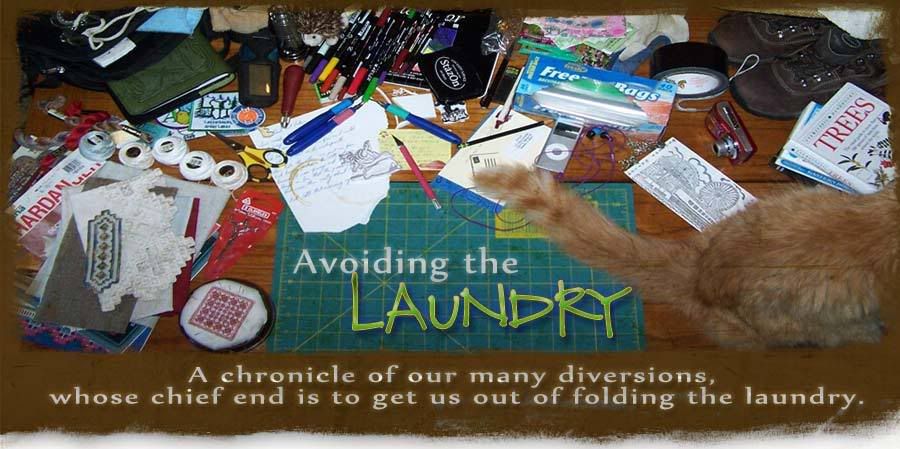Lesson 1--Introduction, Equipment, and Resources
Traditional Hardanger is a type of embroidery done on an even weave fabric in tone on tone colors. That's a starting point at least, and where we are going to begin. It can be done with as few as three types of stitches, or as many as a dozen or more. We'll just keep going until we get bored. See? Some of you are already done.
Fabric
Even weave fabric in 22 to 32 count is typically used for Hardanger. Since it is the largest, and easiest to find locally, we'll use 22 count. White and Ivory are the traditional colors. I have found small packets at both Michael's and Hobby Lobby. Later, I will give you online and mail order sources for supplies.
If you are unfamiliar with embroidery fabric, the thread count indicates the number of threads per inch. In this case, there are 22 threads per inch. If you look closely at a single thread of the fabric, you will notice that it is made up of two parallel strands. This means that it is possible to "split a stitch", or bring your needle up between the two strands when stitching.
It will become second nature to avoid this because it can throw your whole pattern off. Calling it to your attention should be enough to help you watch out for the mistake.
The fabrics can be made of cotton, blends, or linen. I would caution you against beginning with linen. The threads of a linen fabric are not consistently even. This will not be a problem after you've had a bit of practice, but probably isn't the best choice to start with.
Thread
Perle Cotton thread (most commonly available from DMC and Anchor) in sizes 8 and 5 is the thread we are going to learn the stitches with at first. One ball of thread is equal to two skeins. Traditional pieces are white thread on white fabric or ivory on ivory. For demonstration purposes, I am going to stitch with a contrasting color on ivory (ivory photographs slightly better than white). White and ivory also have the advantage of being easiest to find locally. Contrary to logic, the number sizes of fabric, fibers, and needles all increase as the physical size shrinks. Don't ask me why. I didn't make that decision, but a size 8 thread is smaller than a size 5. Don't we wish dress sizes worked the same way?
As with the fabric, look closely at a single strand of thread and you will notice that it is made of two fibers twisted together. Just like with the fabric, you can also "split a stitch" by dividing the fibers of your thread with the needle. Admittedly, this is much less common. It takes a really talented goof up like myself to accomplish such a task.
Needles
You will need tapestry needles in sizes 24 and 26. The good news about tapestry needles is that they have a blunt point, so if you have a habit of jabbing yourself like I do when I stitch, you will be less likely to draw blood. A pin cushion for your needles is optional, but recommended. Your family will thank you. I have several needles tucked under the flap of my scissors case so that they travel flat and without the need of a pin cushion.
Scissors
The only other thing you will need is a pair of embroidery scissors. They vary in price from cheap to ridiculous. Just make sure that you invest in a good pair with sharp points. In Hardanger, the points of the scissors are equally as important as the blades. You will also want to make sure that they have some type of guard for when you are not using them. I bought a pair of 3 Claveles for $25 about 12 years ago and they are still sharp. Do not ever allow anyone to use them for anything other than embroidery. Construction paper snowflakes are out of the question.
Hoops
I don't care if your beloved grandmother does tell you otherwise, do NOT use a hoop with Hardanger embroidery. It is damaging to the fabric and will make your piece look like a used hankie.
Magnifying lamp
A magnifying lamp can be a huge help when working on the close weave fabric and fine stitches of Hardanger. It's easier to get used to using one in the beginning than having to retrain yourself later. I would recommend one on a stand rather than the ones that hang around your neck, but that's just personal preference.
Patterns/Charts
I will provide the patterns for the pieces we will be making together, but there are many good resources for pattern books and the other materials to feed your Hardanger needs. Below are some favorites.
- Nordic Needle is a superb mail order source for needlework supplies of all kinds. Nordic Needle works well when you know what you want. They also have the largest selection of pattern books.
- Stitchville USA, located near Minneapolis, is a stitcher's paradise. It's a great place to visit to see all of the possibilities in fabric and thread. An advantage is that if you have a specific fabric, they will help you choose the right thread for it (or vice versa), even over the phone.
- A piece of 22 count white or ivory fabric, 12 inches square
- 1 skein of matching Perle Cotton thread in size 8 and one in size 5
- Embroidery scissors
- Tapestry needles, size 26, 24
- Patience





